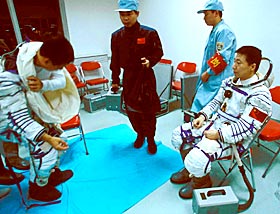China's first manned spacecraft, the Shenzhou V, blasted off from the Jiuquan Satellite Launch Center in the northwestern province of Gansu at 9:00 this morning. The spacecraft, atop a Long March II F rocket, was piloted by Yang Liwei, 38, a lieutenant colonel of the People's Liberation Army (PLA).
Li Jinai, director-general of China's manned space program, announced success of the launch about ten minutes after blast-off, when the spacecraft entered its preset orbit with precision.
China's maiden manned space flight is scheduled to last 21 hours. Success of its launch means that China has become the third country capable of sending people into outer space, following the United States and Russia.
Yang Liwei, a member of the PLA's Astronauts Team, was trained at home.
Yang was born June 1965 in Suizhong County of northeast China's Liaoning Province and joined the Chinese People's Liberation Army (PLA) at 18. He graduated from the No. 8 Aviation College of the PLA Air Force in 1987 with a bachelor's degree and became a fighter pilot. He has had 1,350 hours of flight experience.
In 1998, Yang and 13 other PLA fighter pilots were selected from 1,500 candidates to form the country's first team of would-be astronauts. Su Shuangning, director-general of the astronaut system under China's manned space program, noted that all would-be astronauts have become capable of working and living in space after receiving tough physical, psychological and technical training in the past five years.
After strict selection and examination, an astronaut team for China's first manned spaceflight composed of Yang Liwei, Zhai Zhigang, Nie Haisheng was formed. Shortly before the launch, Yang Liwei was selected as the country's first astronaut due to his excellent performance.
Yang is expected to land somewhere on the grasslands of Inner Mongolia after orbiting the Earth 14 times.
China now has 14 astronauts selected from 1,500 air force pilots in service. Strictly trained in basic theories, specialized technology skills, physical and psychological performances, they all have the makings and abilities required for undertaking manned space flights. To cultivate its own astronauts, China has built a base for the selection and training of astronauts and independently developed products and installations such as training equipment for difficult conditions, simulated spacecraft modules and spacesuits. The Beijing Space Medicine & Medical Engineering Research Institute has undertaken the development and production of the astronaut system for manned space flights.
The Shenzhou V manned spacecraft, jointly developed by the Chinese Academy of Space Technology and Shanghai Academy of Aerospace Technology, two subsidiaries of the China Aerospace Science and Technology Corporation Group, consists of a propelling module, a return module, an orbit module and an annexed part, with a passenger capacity of 3. Its function includes automatic emergency return from orbit and manual control. The China Academy of Launch Vehicle Technology, also a subsidiary of the China Aerospace Science and Technology Corporation Group, built the carrier of the Shenzhou V spacecraft -- the "Long March F" rocket. This model of the binding launch vehicle, developed exclusively for the country's manned space flight, has been successfully launched five times since it sent the first Shenzhou unmanned spacecraft into space on November 20, 1999.
 |
The Manned Spacecraft Launch Site in the Jiuquan Satellite Launch Center is China's new spacecraft launch site put into operation in 1999. Centering on the manned spacecraft, a second landing site, corresponding optical and wireless communication, remote monitoring and control facilities, and astronaut medical supervision and service systems are built.
The manned spacecraft application system will conduct space scientific and technological experiments on the spacecraft.
Relevant departments from the Chinese Academy of Sciences and Ministry of Information Industry developed spacecraft-based instruments and land remote monitoring and control equipment used for space scientific experiments.
For this time's manned space flight, some land emergency rescue sites, sea emergency rescue areas and medical rescue networks have been established. Naval and air forces, the army air force, and the Ministry of Communications send out various kinds of airplanes and ships to await orders in corresponding areas.
When the spacecraft flies in orbit, under the unified control and command of the Beijing Aerospace Command and Control Center, the China Xi'an Satellite Observation and Control Center, relevant observation and control stations at home and abroad and the "Yuanwang" oceangoing space survey fleet will conduct continuous tracking, survey and control of the spacecraft. Through remote monitoring physical parameters, images transmitted back and voice communication, they will know of the astronaut's health, living and working states.
It has been the 71st flight of the Long March Carrier Rocket series and the 29th continuous success in China's space launch history begun October 1996.
(China.org.cn October 15, 2003)